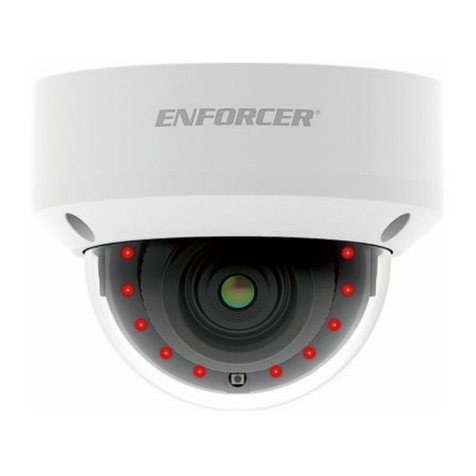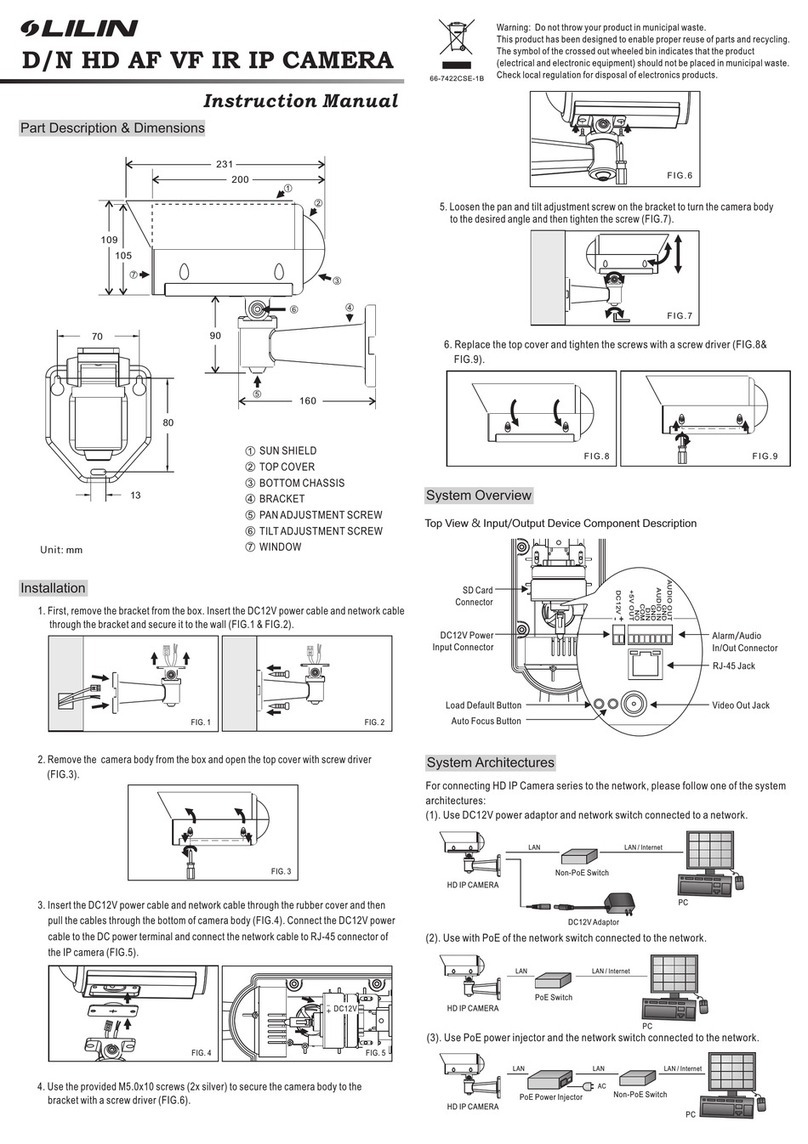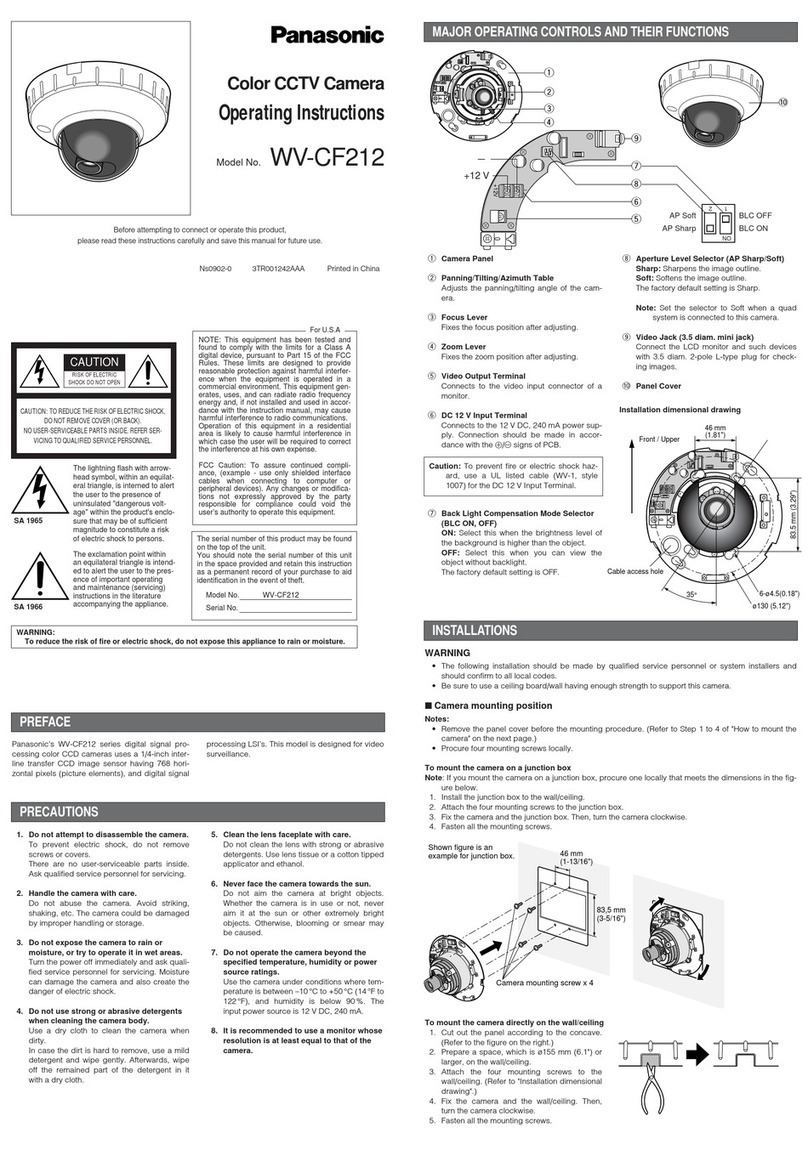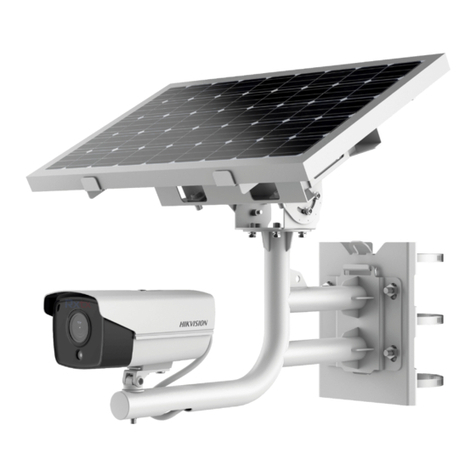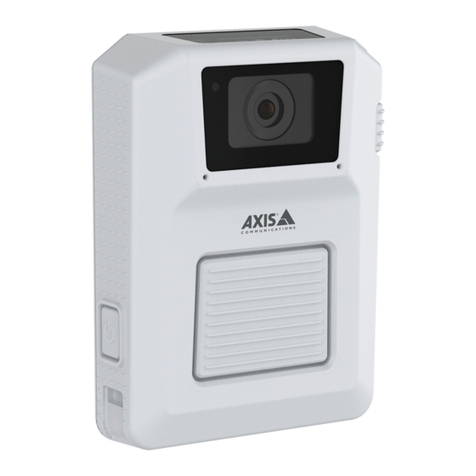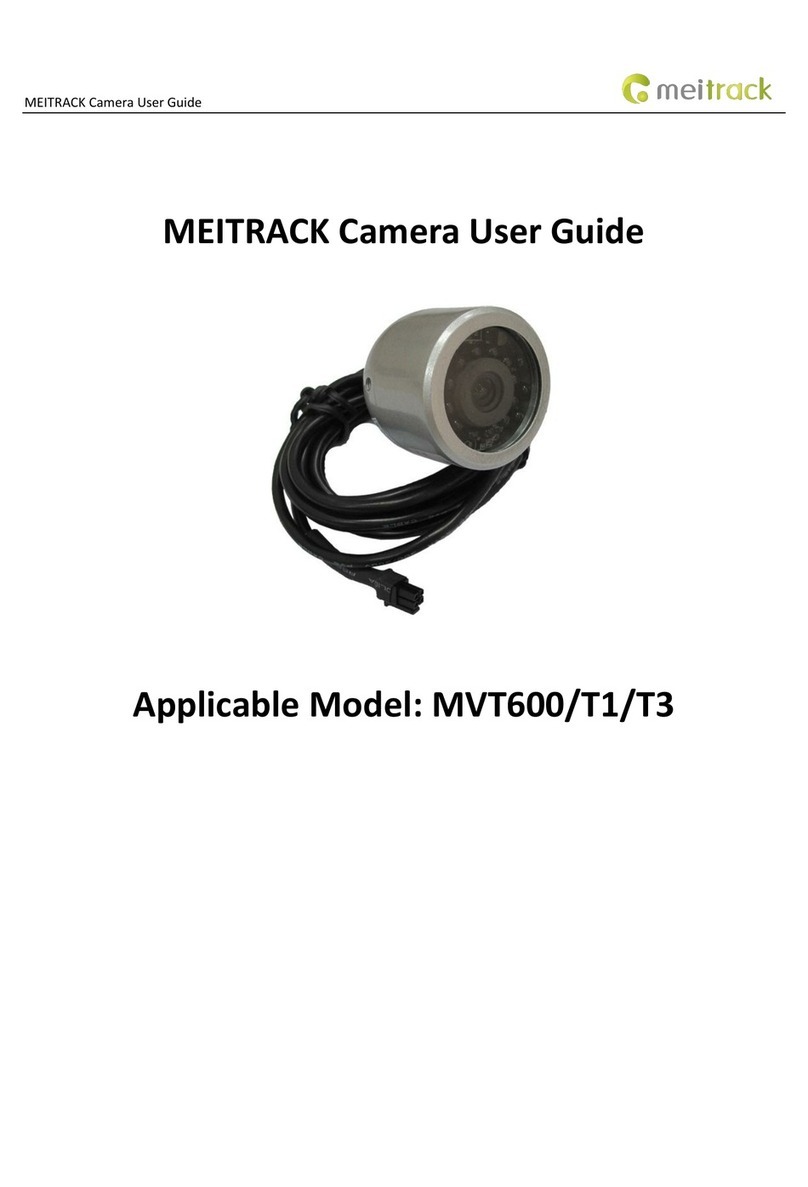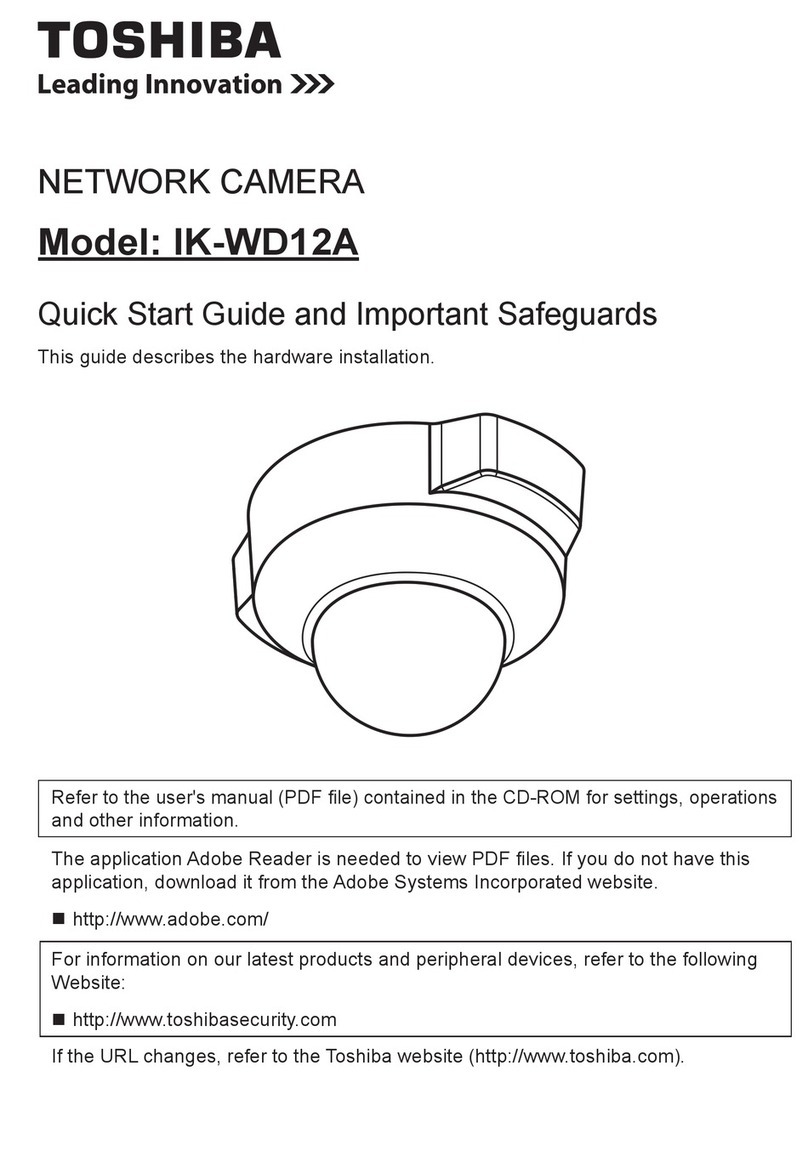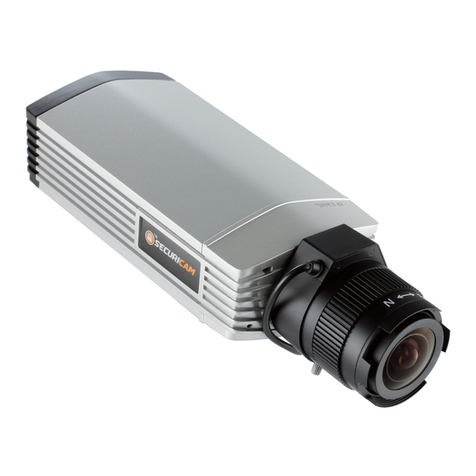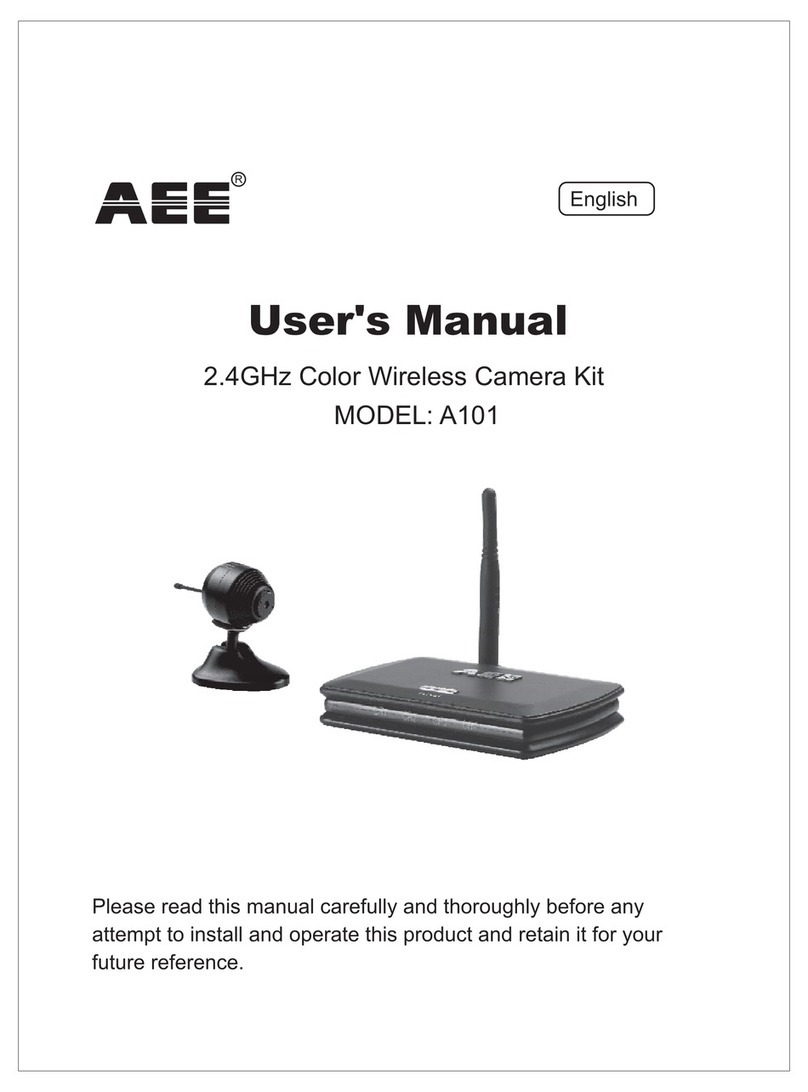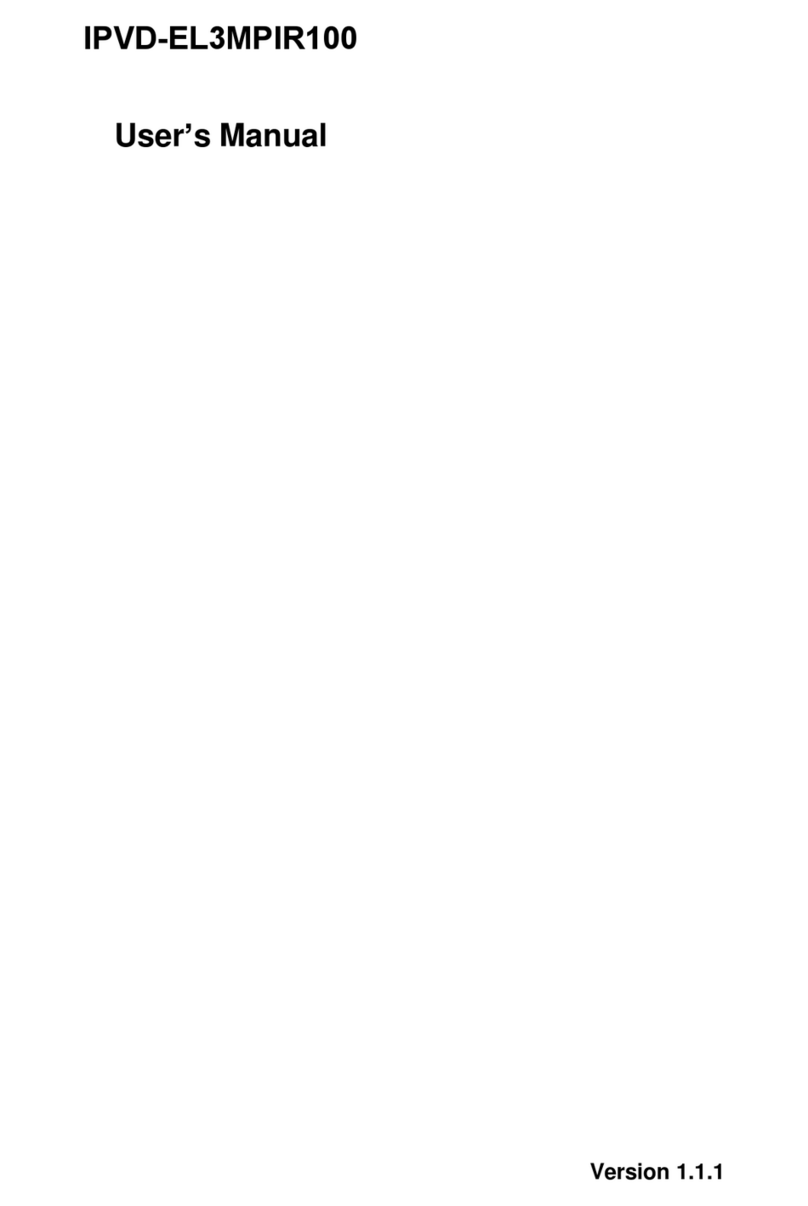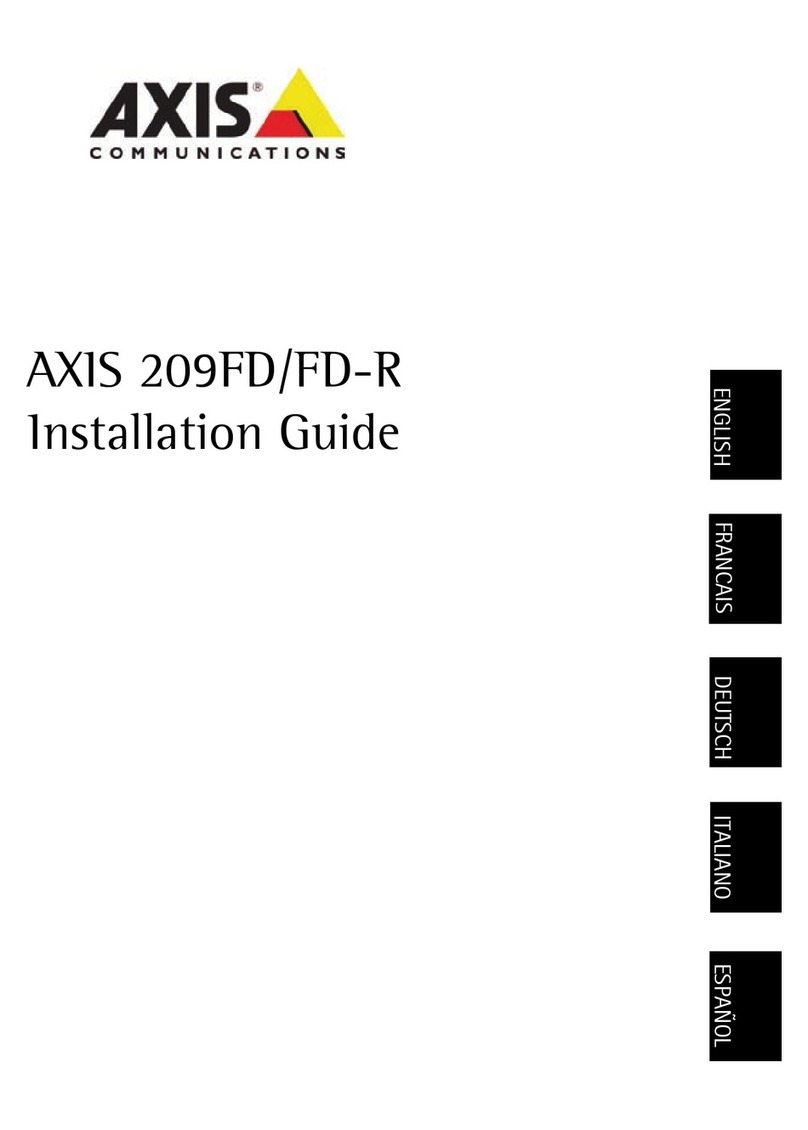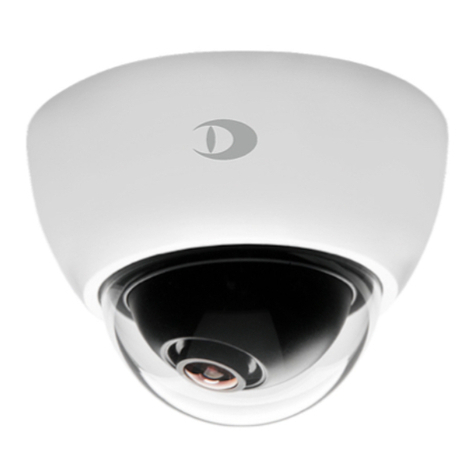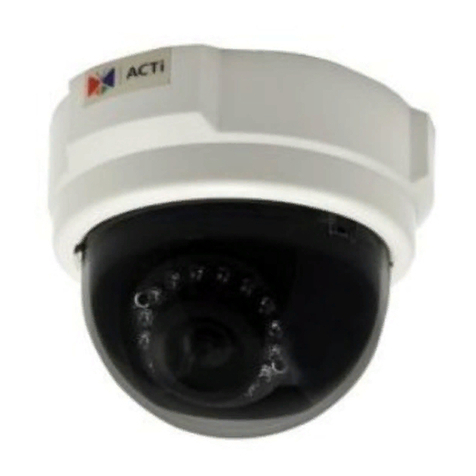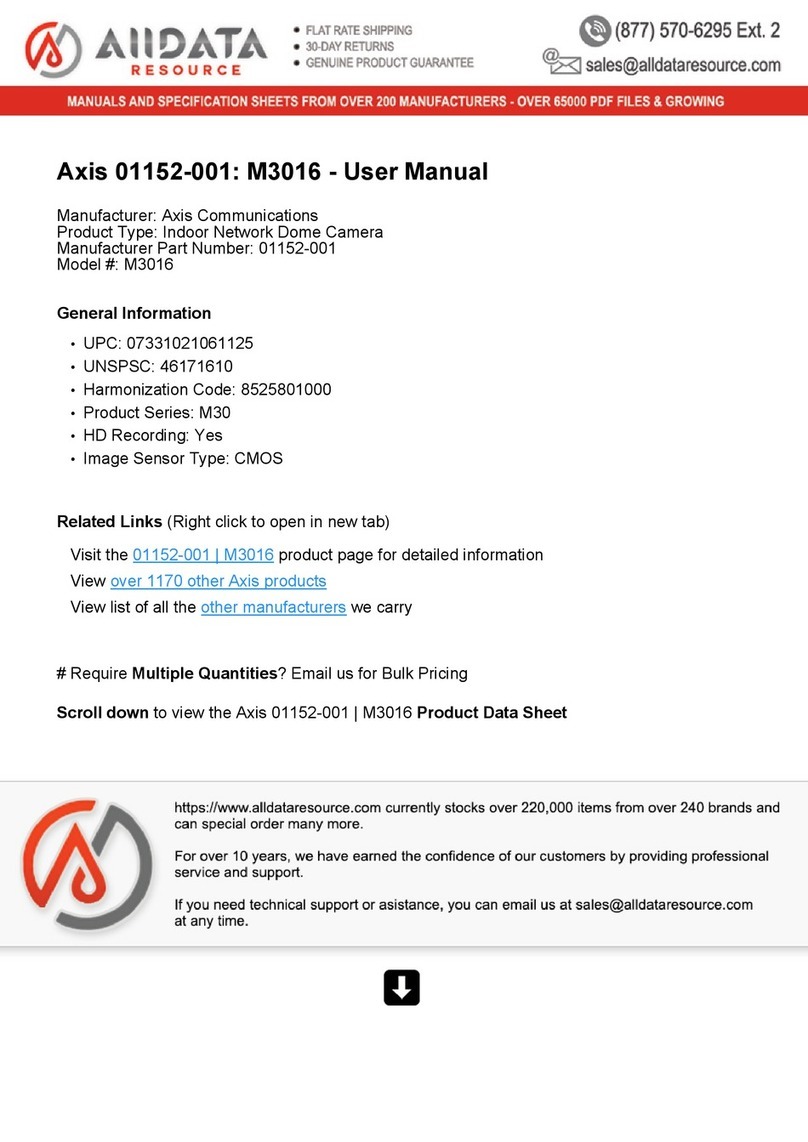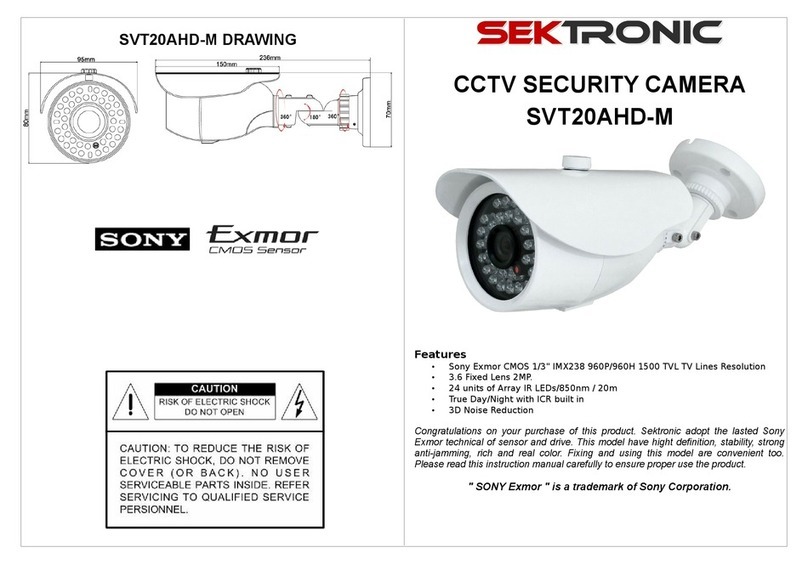fine EP-Q2036HW-IP-AT User manual

Note:
Read this manual carefully before installation
and operation. Keep it handy for later reference.
This manual covers installation and operation of
3 type of speed dome: Indoor In Surface Mount,
Indoor In Ceiling and Outdoor type
SPEED DOME
USER MANUAL

CONTENTS
Part 1: Analog Parts…………....1
FEATURES 1
Canera Parameters 2
■PRECAUTION ................................................ 3
■WARNINGS ................................................... 4
INSTALLATION PREPARATION 5
■TOOL LISTS:.................................................. 5
■ CABLE: .......................................................... 5
■CONNECTION DIAGRAM ........................... 5
■DOME MODE SETTING ............................... 5
■CABLE MODE SETTING.............................. 5
■CONTROLLING TERMINATION
RESISTANCE JUMPER .............................. 6
■ SET DOME ID, BARD RATE AND
PROTOCOL BY ........................................... 6
MOUNT TYPE 7
■IN-CEILING MOUNT .................................... 7
■SURFACE MOUNT ....................................... 7
■WALL MOUNT .............................................. 7
■CORNER MOUNT ......................................... 8
■POLE MOUNT ............................................... 8
■PENDANT MOUNT ....................................... 8
INSTALLATION GUIDE 9
■IN-CEILING MOUNT .................................... 9
■ SURFACE MOUNT .................................... 11
■CORNER MOUNT ....................................... 14
■POLE MOUNT ............................................. 16
■PENDANT MOUNT ..................................... 18
S Y S T E M C O N N E C T I O N 21
M E N U I N D E X 22
■BOOT-UP THE SCREEN ............................. 23
■WORKING MENU AS FOLLOW ............... 23
■ MENU OPERATION ................................... 23
■ ENTER THE MAIN MENU ........................ 23
■SELECT THE MENU ITEM ........................ 23
■CHANGE VALUE ........................................ 24
■ EDIT THE TITLE ........................................ 24
■TIME SETTING ............................................ 25
■PASSWORD SETTING ................................ 25
FACTORY SETTING 25
■SYSTEM RESTART SETTING ................... 25
■CAMERA PARAMETERS........................... 25
■LENS PARAMETERS .................................. 25
◆ZOOM SPEED SETTING ................................ 25
Operation settings as follows: ............................... 25
◆DIGITAL ZOOM SETTING ............................ 26
Operation settings as follows: ............................... 26
◆FOCUS LIMIT SETTING ................................ 26
◆PICTURE FREEZE SETTING ........................ 26
◆IMAGE STABILIZER SETTING .................... 26
■EXPOSURE MODE ...................................... 26
◆EXPOSURE MODE SETTING ....................... 26
◆SHUTTER SPEED SETTING.......................... 27
◆IRIS LEVEL SETTING ................................... 27
◆BRIGHT LEVEL SETTING ............................ 27
◆AGC LEVEL SETTING .................................. 27
◆DIGI-SLOW SHUTTER SETTING ................ 27
◆DAY/NIGHT MODE SETTING ..................... 27
■WHITE BALANCE ...................................... 28
◆WHITE BALANCE SETTING ........................ 28
◆RED GAIN SETTING ..................................... 28
◆BLUE GAIN SETTING ................................... 28
■BACKLIGHT MODE SETTING ................. 28
◆BACKLIGHT MODE SETTING..................... 28
◆WIDE DYNAMIC MODE SETTING ............. 29
◆PRIVACY MASK SETTING .......................... 29
PAN TILT SETTING 29
■PAN TILT SETTING ................................... 29
◆AUTO FLIP...................................................... 30
◆JOYSTICK RECOVER ................................... 30
◆SPEED PROPORTIONAL .............................. 30
■PRESET SETUP MENU .............................. 30
◆PRESET NUMBER SETTING ........................ 31
◆TITLE SETTING ............................................. 31
◆PRESET SETTING .......................................... 31
■CRUISE SEQUEUE SETTING .................... 31
◆CRUISE SEQUENCE NUMBER SETTING .. 31
■PATTERN SETUP ....................................... 32
■ZONES SETUP............................................. 32
■TIME ACTION ............................................. 32
■HOME TIME SETTING............................... 33
■DISPLAY CONFIGURATION .................... 33
■DOME TITLE ............................................... 33
■MOTION DETECTION ............................... 33
■ALARM ACTION ........................................ 34
■AREA SETTING .......................................... 34
■RELAY OUTPUT......................................... 34
■RESET RELAY ............................................ 34
■ALARM ACTION ........................................ 35
APPENDIX I:Special Function Operation…………36
APPENDIX II:DIP SWITCH SETTINGS…………...37
APPENDIX III:WIRE DIAMETER &
RANSMISSION CHART………………………….41
APPENDIX IV:RS485 BASIC KNOWLEDGE…42
APPENDIX V :…………………………………..46
Part 2:IP Parts Function….…..48
I. Preface…………………………………………....48
II. Specifications…………………………….……..48
III. Product Installation………………………..........48
A. Monitor Setting ........................................... 48
B. IP Assignment............................................. 49
C. Install ActiveX control: ............................. .52
IV Live Video……………………………………...54
V. Configuration …………………………………....56
A. System …………………………………….57
B. Network ...................................................... 63
C. A/V Setting ................................................. 67
D. Event List .................................................... 73
VI.Factory Default………………………………76

1
FEATURES
Product Features
With high quality motor, low power consumption,
no vibration even in extremely slow rotation.
Low temperature protection
Support many camera module options.
Discreet surveillance with black liner.
With vandal-resistant down cover option.
With Multi-language OSD menu, (Chinese, English, French,
German, Russian, Italian, Portuguese, Spanish etc.),
User-friendly interface, easy operation.
Built in multi-protocols
Snap-in structure, quick and easy installation.
Variable speed, 360°continuously pan , 180°tilt with auto flip.
With Compass, display camera direction on the screen.
With camera internal temperature and environment temperature display.
Motion detection
255 presets with ±0.01° accuracy.
Preset Speed: 320°/s
8 tours, 32 presets per tour
8 patterns, 8 preset tours, 8 zones with title
16 privacy masks(SONY 36x Module)
Soft address modification function,easier for debug
With editable ID set from OSD menu, easier for debug.
OSD menu password protection
Built in 2alarm inputs and 2 alarm outputs (For Analog type using only).
Camera ID editable with max. 40 English characters in one line.
Can set to start pattern or go to one preset after alarm activated (For Analog type using only).
Can set time to reset the alarm automatically (For Analog type using only).
Proportional Pan/tilt.
Auto restore the memory against power off.
Auto running the previous function after power off
Built in clock, can set function according to schedule.
Built in multi protocols via RS485 (Pelco P, D, VLC, VICON, KALATEL, MOLYNX, DIAMOND, PANASONIC etc.), and
support Pelco-coaxitron, AD Manchester, Bosch Bi-phase etc.
IP66, built in thermostat.
Lightning proof and surge proof.
Operating Temperature
Model Absolute Max Sustained Max Absolute Min Sustained Min
In-Ceiling Indoor 32° to 122°F (0° to 50°C)
Standard Pendant 113°F (45°C) 95°F (35°C) -4°F (-20°C) 14°F (-10°C)
Environmental Mount 158°F (70°C) 140°F (60°C) -60°F (-51°C) -50°F (-45°C)
Note:
1. Assume no wind chill factor
2. Prevents icing at sustained minimum of -50°F (-45°C)
3. De-ices 0.1 inch (2.5 mm) within 3 hours after power-up

2
Camera Parameters
Model
Speed Dome Outdoor Type
Speed Dome Indoor -SM Type (Surface Mount)
Speed Dome Indoor -CM Type (In Ceiling)
Image Sensor 1/4" SONY Super HADⅡ(Double Scan) CCD
TV System PAL: 1028 (H) x 596 (V) ; 2:1 interlace NTSC: 1028 (H) x 508 (V) ; 2:1 Interlace
Horizontal Resolution Max 700 TV lines in color @ HR 7 mode (750TV lines in B/W @ HR 7 code)
Synchronization Internal / External V-lock
Optical Lens 36X Optical Zoom, f=3.4mm(wide) - 122.4mm (tele), F1.6 -4.5 (tele)
Digital Zoom Digital x32 zoom
E.Zoom Off / Max x2 ~x 32
Video Output 1.0Vp-p (sync negative) (75 ohms, composite)
Exposure Auto / Shutter PRI / Iris PRI / Manual
Gain Control On/off (max 30dB)
Minimum Illumination Color : 0.5 lux , BW : 0.2 lux
Color DSS : 0.001 lux , BW DSS : 0.0004Lux
S/N ratio more than 50dB (AGC off)
Shutter Speed NTSC: 1/60~1/100,000 sec
PAL: 1/50~1/100,000 sec
Iris 1~18
Digital Slow Shutter Off/Max x 2 ~x 512
Flickerless Off / on
Brightness 1~15 steps
White Balance ATW / One Push / Indoor / Outdoor / Manual / Auto
WDR/BLC Off/WDR/BLC
AE Compensation Auto, Manual, Backlight compensation, EV compensation, priority mode, Bright, Slow AE
EV Compensation -10.5 +10.5dB (1.5 dBsteps)
Focusing System Auto (sensitivity: normal, low), One-push AF, manual, Infinity, Interval AF, Zoom Trigger AF
Day Night Function Yes, with ICR Cut Filter
Aperture Control Auto / manual
Preset 255 positions
Focus Auto / One push / Manual
Focus Distance 0.1/1.3/1.8/3.0/5.0 m
OSD Language Chinese, English, Italian, Spanish, German, French, Russian and Portuguese, POLSKI
Operating Temperature Indoor: -10℃ to + 50℃ ('14℉ to 122℉)
Outdoor:-40℃ to + 70℃ (-40℉ to 158℉)
Storage Temperature -20℃ to + 60℃ (- 4℉ to 140℉)
Power Supply AC24V, 50/60Hz
Power Consumption Indoor 10w, outdoor 50w
Network Ethernet 10 / 100 Base–T

3
Network Protocols
TCP / IP, DHCP, HTTP, DHCP, PPPoE, FTP, RTSP, DDNS, NTP
Image Frame Rate 30/25 fps (NTSC/PAL)
Compression Format H.264/JPEG
Video Bit Rate Adjust Cbr, vbr
Motion Detection Yes, 3 different areas
Triggered Action Yes , configurable
Simultaneous Connection Up to 10
Image Mirror OFF/ALL/UD/LR
SDK Provided upon customer request
Mechanical Specifications
Pan Range 360 ∘continuous
Tilt Range 90 degrees
Manual Pan Speed
0.1- 160 degree/ sec.
Manual Tilt Speed
Preset Speeds Pan: more than 360 degrees , tilt: more than 360 degrees
DECLARATION
This equipment generates, uses, and can radiate
radio frequency energy and, if not installed and used
in accordance with the instruction manual, may
cause harmful interference to radio communications.
Operation of this equipment in a residential area is
likely to cause harmful interference in which case the
user will be required to correct the interference at
the user’s own expense.
■PRECAUTION
Only qualified and experienced person can
carry out the installation. In many
countries and areas licensed personnel is
required
Always take safety codes into
consideration during installation.
Use reliable tools only, poor quality tools
may cause damage to both human and
property.
Check the strength of all item that are
related to installation in advance. It is
recommended that the stand of dome be 8
times stronger than the weight of the dome
and its accessories.
Keep all the original dome package
materials in case of future repacking and
transportation.
Choose and install speed dome according
to environment requirement (Refer to the
Product Features).
This product conforms to IP66 standard as
specified in “Housing Protection
Classification (IP code)”.
model indoor outdoor
temperature -10~50℃ -30~50℃
humidity <90%
Air pressure 86~106KPa
power AC24V/1.25A, 50/60Hz

4
■WARNINGS
Avoid installing this speed dome in
hazardous places where inflammable or
explosive materials are stored or used.
The installation of this product must be
strict compliance with national and
regional use of the electrical safety
regulations this speed dome runs on 24v
AC.
Make sure during the installation process
you may be exposed to a fixed installation
location near the power and the power of
this product has been disconnected.
The use of the product voltage is 24VAC;
prohibition will be higher than the voltage
required manufacturers to connect
directly to this product.
It shall not exceed the environmental
where requirements of this product install
the product
In this manual 24VAC power cables for
short power cable; RS485 communication
cable referred to as the communication
cable; BNC video coax video cable for
short.
All outlet water should be done to deal
with.
Dome should connect the ADC alone, and
the ADC resistance can not larger than 4
Ω,so it can lightning proof and surge
proof.

5
INSTALLATION
PREPARATION
■TOOL LISTS:
The following tools may be needed for the
installation:
Screw and nut, Screwed driver, Small slotted
screwed driver,Wire cutter,Ladder,Drill,Saw.
■ CABLE:
Coaxial Cable
75 impedance
Solid copper wire
95% braided copper shield
Check the transmission distance referring
to the chart below.
Model Distance
RG 59/U 750ft(229m)
RG 6/U 1,000ft(305m)
RG 16/U 1,500ft(457m)
RS485/RS422 Cable
0.56mm (24AWG) twisted pair wire
maximum transmission distances are as
follows.
Baudrate Distance
2400bps 5906ft(1800m)
4800bps 3937ft(1200m)
9600bps 2625ft(800m)
■CONNECTION DIAGRAM
■DOME MODE SETTING
The default of Dome is common
simulation(SW1 ON),SWI can set to common
dome or Net dome.
SW1 ON: The Ext-cable move round IP
mainboard socket connect the dome
mainboard directly, just the Ext-cable can
control.
SW1 OFF: The Ext-cable connect the IP
mainboard socket which connect the dome
mainboard, the IP template can control the
dome with the Ext-cable simultaneously
Jumper JP3 is to set the communication mode
RS485 or RS422. When it is RS485, dome is
working with half-duplex mode, sending data to
controlling equipment via RS485+/RS485-.
When it is RS422, dome is working with duplex
mode, sending data to controlling equipment
via RS422 TX+/RS422 TX-. (RS422
communication is only effective for specific
models when the protocol supporting RS422).
■CABLE MODE SETTING
1、 Power/RS CABLE terminal J1
AC :AC 24V
:EARTH (Note: To connect the right
earth ADC, can be lightning proof and surge
proof.)
AC :AC 24V
NC :None Connection
RX- : RS422 RX +(RS485+)
RX+ : RS422 RX- (RS485-)
TX- : RS422 TX-(just for RS422 dome)
TX+ : RS422 TX+(just for RS422 dome)

6
2、 Video Connection terminal J2
VGND VIDEO
VGND : VIDEO-
VIDEO : VIDEO+
3、 Alarm input/output socket J3
COM A1 A2 A3 A4 01A 01B 02A 02B
COM :ALARM COM
A1~A4 :Alarm IN 1~4
O1A~O1B :Alarm out 1
O2A~O2B :Alarm out 2
4、 RJ45 Connection terminal J12
To connect with Ethernet.
■CONTROLLING TERMINATION
RESISTANCE JUMPER
RS422/RS485 just need one 120Ω resistance.
At the farthest distance (keyboard and dome),
the default is OFF.
JP1:RS422RX/RS485
JP2:RS422TX
JP1/JP2 set on, connect the termination
resistance,set OFF, unconnected the
termination.
■ SET DOME ID, BARD RATE
AND PROTOCOL BY
configuring DIP switches (Refer to APPENDIX
Ⅱ).。
SW 1 SW 2
Dome set the ID, Baud Ratio and
control protocol by the DIP SW1 and
SW2 in the side of the module.
Function
DIP
Control
Protocol
DIP SW1 1
-
6
Baud
ratio
DIP SW1 7
-
8
Dome
ID
DIP SW2 1
-
8
Refer to the appendix II

- 7-
MOUNT TYPE
■IN-CEILING MOUNT
■SURFACE MOUNT
■WALL MOUNT
2 2 5
2 4 7
1 6
5
1 0 0
2 2 5

- 8-
■CORNER MOUNT
■POLE MOUNT
■PENDANT MOUNT

- 9-
INSTALLATION GUIDE
■IN-CEILING MOUNT
Maximum thickness of the ceiling is 42mm and the
ceiling should be able to hold 8 times of the weight of
the speed dome. More than 20cm of clear space is
needed above the ceiling.
1. Mark the hole on ceiling.
2. Mark a 225 mm circle on the proper position
of the ceiling using the accessory paper sheet
3. Make the hole.
Cut the hole with proper tool. Make sure the
tolerance is less than +2mm.
2 2 5
4.Unfasten the circuit board.
Unscrew the screw to open the circuit board on
connection board.
5.Cross cables.
Prepare wiring and then put Power/RS485/ Video
cables through waterproof connector on the top of
housing. Turn the connector into the top hole of the
housing
Water-proof
Connector
6.Connect cables.
Plug cables into corresponding sockets on circuit
board. When finished, fix the circuit board back
and turn on the power. The red LED will light.
Turn off the power after checking.
NOTE: There are signs for each port. Fix cables as
picture shows. Make sure power is off before
connecting.

- 10-
7.Adjust clips.
Adjust the height of the mounting clips. Swing the
mounting clips to adhere to housing.
Ceiling Thickness
Mounting Clip
8.Install housing.
Push housing into ceiling and let the clips stretch
out. Finally, screw the three clips to tighten the
housing
9.Set dome ID, baud rate and protocol.
Set dome ID, bard rate and protocol by configuring
DIP switches (Refer to APPENDIXⅡ).
NOTE: Remove the packing sponges.
SW 1 SW 2
10.Install Pan/Tilt Module.
Push the black liner into the two tabs. Install the
pan/tilt module with two clips, match color of AMP
sockets. Gently push the module upward until
hearing two clicks.
NOTE: Remove the lens cover
Sam e Color
AM P Socket
Tab
Tab
11.Install down cover.
Fasten the safety chain on housing. Align clasps
and mounting holes then turn clock-wise.
NOTE: Let the safety chain inside the arc groove of
the down cover, otherwise it may scratch the lens.
lube M4 slot

- 11-
■ SURFACE MOUNT
The thickness of the ceiling should be able to hold
the expansion screw and the ceiling is firm enough to
hold 8 times of the weight of the speed dome.
1. Install the mounting base
Take the mount base as patter to mark the mounting
position on the ceiling surface. And then fix the
mounting base on the ceiling. Cross the cables through
the base.
2. Connect cables.
Plug cables into corresponding sockets on circuit
board. When finished, fix the circuit board back
and turn on the power. The red LED will light.
Turn off the power after checking.
NOTE: There are signs for each port. Fix cables as
picture shows. Make sure power is off before
connecting.
3. Set dome ID, baud rate and protocol.
Set dome ID, bard rate and protocol by configuring
DIP switches (refer to APPENDIX Ⅱ).
SW 1 SW 2
4. Install black liner and Pan/Tilt Module.
Push the black liner into the two tabs. Install the pan/tilt
module with two clips, match color of AMP sockets.
Gently push the module upward until hearing the click.
NOTE: Remove the lens cover
4. Install down cover
Fasten the safety chain on housing. Align the tabs on
the down cover with the slide holes on the mounting
base. Push the down cover upward and spin it
clockwise to fix the down cover on the mounting
base.

-12-
■WALL MOUNT
Check carefully to make sure the wall is firm and does
not peel off. It is required that the wall can withstand 8
times weight of the dome set.
1. Mark mounting position
Use bracket to mark the mounting position on wall.
2. Install bracket.
Connect all cables through the hole of bracket, and fix
bracket on the wall with 2 M8 screw.
NOTE: Put cables through the wall or aside the
bracket.
3.Unscrew to release the circuit board on
connection board.
4.Install housing
Cross cables through the hole on top of the housing.
Align the fast connector to bracket and fix with 2 M5
screws.
NOTE: Apply water-proof tape to the thread in the case
of outdoor dome
M5 SCREW
TAPE
5.Connect cables.
Plug cables into corresponding sockets on circuit board.
Reinstall the circuit board and turn on the power. The
red LED is on if connections are correct. Turn off the
power after checking.
NOTE: Names of the interfaces are marked on terminal
block or PCB. Connect cables as picture shows. Make
sure power is off before connecting.

-13-
6.Set dome ID, baud rate and protocol.
Set dome ID, bard rate and protocol by configuring
DIP switches (Refer to APPENDIX Ⅱ).
SW 1 SW 2
7.Down cover preliminary installation.
Attach the safety chain with a M3 nut as picture shows.
NOTE: Outdoor need plug the heating cable.
8.Install black liner and Pan/Tilt Module.
Push the black liner into the two tabs. Install the pan/tilt
module with two clips, match color of AMP sockets.
Gently push the module upward until hearing the click.
NOTE: Remove the lens cover
AMP SOCKET
Tab
Black Liner
9.Install down cover.
Unscrew the two M4 screw on down cover ring. Push
up the down cover into the housing and then fasten
down cover with two M4 screws.
NOTE: Apply lube to the O-ring in the case of outdoor
dome
lube M4 slot

-14-
■CORNER MOUNT
Check carefully to make sure the wall is firm and does
not peel off. It is required that the wall can withstand 8
times weight of the dome set.
1. Mark the fastener positions.
Use the corner mount base as the template to mark
the mounting positions on wall.
2. Install base.
Put Power/RS485/ Video cables through the hole of
corner mount base and use M8 nuts to fasten
corner base on the mounting surface.
NOTE: Put cables through the wall of aside the
corner base
3. Install bracket.
Put cables through the cavity of bracket and fasten
bracket on base
4.
Unscrew to release the circuit board on
connection board.
5.Install housing.
Cross cables through the hole on top of the housing.
Align the fast connector to bracket and fix with 2
M5 screws
NOTE: Apply water-proof tape to the thread in the
case of outdoor dome
6.Connect cables.
Plug cables into corresponding sockets on circuit
board. Reinstall the circuit board and turn on the
power. The red LED is on if connections are
correct. Turn off the power after checking.
NOTE: Names of the interfaces are marked on
terminal block or PCB. Connect cables as picture
shows. Make sure power is off before connecting
M5 SCREW
TAPE

-15-
7.Set dome ID, baud rate and protocol.
Set dome ID, bard rate and protocol by configuring
DIP switches (Refer to APPENDIX Ⅱ).
SW 1 SW 2
8.Down cover preliminary installation.
Attach the safety chain with a M3 screw as picture
shows.
9.Install black liner and Pan/Tilt Module.
Push the black liner into the two tabs. Install the
pan/tilt module with two clips, match color of AMP
sockets. Gently push the module upward until
hearing two clicks.
NOTE: Remove the lens cover.
SOCKET
Tab
Black Liner
10.Install down cover.
Unscrew the two M4 screws on down cover ring.
Push up the down cover into the housing, and then
fasten down cover with two M4 screws.
NOTE: Apply the lube to the O-ring in the case of
outdoor dome
lube M4 slot

-16-
■POLE MOUNT
Pole mount is applicable to installation on pole with
diameter of 130-150mm (5.12”~6”)
1. Install base.
Put Power/RS485/ Video cables through the
central hole of the bracket base, and then fix it to
the pole
2. Install bracket.
Put cables through the cavity of bracket and fasten
it on base.
3. Release the circuit board.
Unscrew to release the circuit board on connection
board.
4. Install housing.
Cross cables through the hole on top of the housing.
Align the fast connector to bracket and fix with 2
M5 screw
NOTE: Apply water-proof tape to the thread in the
case of outdoor dome
M5 SCREW
TAPE
5. Connect cables.
Plug cables into corresponding sockets on circuit
board. Reinstall the circuit board and turn on the
power. The red LED is on if connections are
correct. Turn off the power after checking.
NOTE: Names of the interfaces are marked on
terminal block or PCB. Connect cables as picture
shows. Make sure power is off before connecting

-17-
6.Set dome ID, baud rate and protocol.
Set dome ID, bard rate and protocol by configuring
DIP switches (Refer to APPENDIX Ⅱ).
NOTE: Remove the packing sponge.
SW 1 SW 2
7. Down cover preliminary installation.
Attach the safety chain with a M3 screw as picture
shows.
8. Install black liner and Pan/Tilt Module.
Push the black liner into the two tabs. Install the
pan/tilt module with two clips, match color of AMP
sockets. Gently push the module upward until
hearing two clicks.
NOTE: Remove the lens cover.
AMP SOCKET
Tab
Black Liner
9. Install down cover.
Unscrew the two M4 screws on down cover ring.
Push up the down cover into the housing and then
fasten down cover with two M4 screws.
NOTE: Apply the lube to the O-ring in the case of
outdoor dome
lube M4 slot

-18-
■PENDANT MOUNT
In case of low ceiling height dome can be mounted
directly into the base flange.
1. Mark the mounting position.
Use the bracket base to mark the fastener positions
on ceiling
2. Install base.
Connect wirings through the central hole of the
bracket base, and then fix it on ceiling.
NOTE: Put silica gel along the top of bracket base
in the case of outdoor dome.
3. Install suspender.
Connect wirings through the cavity of suspender,
and then turn the threaded pipe head into the
bracket base and fasten the connection with a M5
screw.
NOTE: Apply water-proof tape to the thread and
put silica gel to the suspender as picture shows in
the case of outdoor doom.
4. Release the circuit board.
Unscrew to release the circuit board from
connection base
5. Install housing.
Connect cables through the top hole of the
Table of contents
Other fine Security Camera manuals

